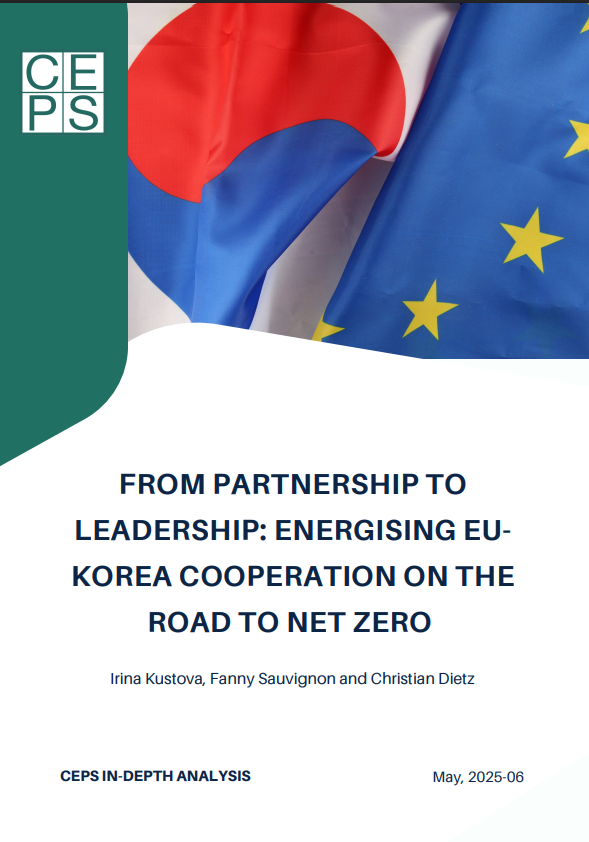
□ EU-한국 녹색 파트너십을 통해 산업 및 에너지 시스템의 탈탄소화, 글로벌 기후 목표 증진, 기술 협력, 규제 및 외교 프레임워크 강화 등 구체적인 협력 기회를 탐색함
ㅇ 양측이 ▲산업 및 에너지 시스템의 탈탄소화 ▲글로벌 기후 목표 증진 ▲기술 협력 ▲규제 및 외교 프레임워크 강화 등을 통해 협력을 심화시킬 수 있는 방안을 제시함
ㅇ 특히, 한국의 수소, 탄소포집·저장(CCUS), 소형모듈원자로(SMR) 등 청정 기술 분야에서의 리더십을 활용하여 EU와의 협력을 통해 이러한 기술의 상용화 및 확산을 가속화할 수 있음
□ 한국의 정치적 변화가 기후 정책에 미치는 영향을 분석하며, 지속 가능한 협력을 위해서는 정치적 안정성과 일관된 정책 추진이 중요하다고 강조함
목차
INTRODUCTION: NOW IS THE TIME TO DOUBLE DOWN ON EU-KOREA CLEAN INDUSTRIAL COOPERATION 1
1. UNDERSTANDING THE GREEN TRANSITION IN SOUTH KOREA 4
1. 1. FROM THE KOREAN DEVELOPMENTAL STATE TO GREEN GROWTH (1980S-2017) 5
1. 1. 1. Industrial and environmental legacies of the developmental state (1980s-90s) 5
1. 1. 2. Post-crisis but pre-‘Green Growth’: Liberal leadership in a market economy (1998-2008) 7
1. 1. 3. The turn to Green Growth: Cleantech and global ambitions (2009-17) 9
1. 2. FROM THE KOREAN GREEN NEW DEAL TO CARBON NEUTRALITY: CLIMATE POLICIES UNDER THE MOON ADMINISTRATION (2017-22) 12
1. 2. 1. A ‘nuclear-free’ Korea? 13
1. 2. 2. Ambitious renewable energy policies and the RE3020 plan 14
1. 2. 3. The Korean (Green) New Deal 15
1. 2. 4. Carbon neutrality and sustainable development 16
1. 3. REFRAMING CARBON NEUTRALITY UNDER THE YOON ADMINISTRATION (2022-25) 17
1. 3. 1. From renewables back to nuclear energy 18
1. 3. 2. Realisable carbon neutrality 19
1. 3. 3. What has been left of the Korean Green New Deal? 19
1. 4. THE FUTURE OF GREEN POLICIES AMID POLITICAL UNCERTAINTY (2025) 20
2. FROM A CARBON-INTENSIVE EXPORT-ORIENTED ECONOMY TO GREEN GROWTH AND INNOVATION 22
2. 1. EMISSIONS AND ECONOMIC GROWTH IN A RESOURCE-POOR SETUP 23
2. 1. 1. Export-oriented manufacturing as South Korea’s path to growth 23
2. 1. 2. South Korea’s carbon intensity improvements: A trend towards decoupling emissions and growth? 29
2. 2. CARBON NEUTRALITY THROUGH GREEN GROWTH AND TECHNOLOGICAL INNOVATION 32
2. 2. 1. Emissions reduction pathways by 2030 and beyond 33
2. 2. 2. Cleantech manufacturing and an environment for innovation 35
2. 2. 3. Decarbonising the power sector and industry 38
The power sector 39
2. 2. 4. Mid-term technological innovation across sectors 44
2. 3. CARBON PRICING AS A LONG-TERM INVESTMENT SIGNAL FOR THE LOW-CARBON TRANSITION 48
2. 3. 1. Korea’s ETS: Increasing environmental integrity 48
2. 3. 1. K-ETS as an example of good practice in the region: External perceptions of effectiveness 52
2. 3. 2. Beyond carbon pricing: Creating a business case for low-carbon goods 53
3. KEY PATHWAYS TO DEEPEN EU-KOREA COOPERATION ON THE GREEN TRANSITION 56
3. 1. A GREEN PARTNERSHIP 56
3. 2. BETWEEN PARTNERSHIP AND REGULATORY INFLUENCE: A ‘BRUSSELS EFFECT’ IN KOREA? 58
3. 3. STRATEGIC ENTRY POINTS FOR MORE EU-KOREA COOPERATION: LOW-HANGING FRUIT WITH A HIGH IMPACT 60
3. 3. 1. Strengthening national climate ambitions and global climate cooperation 60
3. 3. 2. Innovation and deployment of clean technologies 61
3. 3. 3. Enabling (regulatory) frameworks for carbon neutrality 63
3. 3. 4. Finding a path out of the woods: EU-Korea dialogue on CBAM 65
3. 3. 5. Facilitating EU-Korea business and research interaction and creating integrated
ecosystems for innovation 68
CONCLUSIONS: TAKING THE EU-KOREA PARTNERSHIP TO THE NEXT LEVEL 69
ANNEXES 70
ANNEX A ELECTED PRESIDENTS OF THE SIXTH REPUBLIC 70
ANNEX B SOUTH KOREA’S LEGAL, LEGISLATIVE AND JUDICIAL SYSTEM 70
ANNEX C PROJECTS UNDER KOREA’S GREEN NEW DEAL (2020-25) 71
NOTES 73


